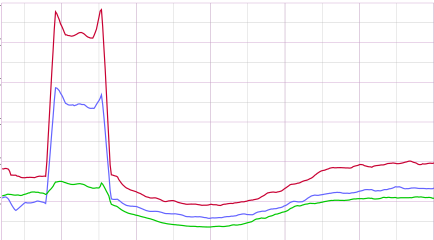Parse custom udp dns request using tcpdump
Reacting to the next “pseudorandom subdomain” ( PRSD ) DDoS, and they are very clearly visible on the graph of outgoing requests:

I came across a strange udp request.
The standard udp request-response looks like this:
')
But sometimes in the tcpdump logs you can see the following:
The request almost did not change, but the field appeared: [b2 & 3 = 0x180] (there may be different values).
What does it mean?
The tcpdump documentation says:
If you look at what the dns header of the package consists of , you can see the following:
We are interested in the field:
| QR | Opcode | AA | TC | RD | RA | Z | RCODE |
If 0x180 translate into a binary number system, we get:
Since byte 16, then the final number looks like this:
0000 0001 1000 0000
If you look at the header of the packet, you can see that the packet contains bits responsible for the recursion. RD - recursion desired and RA - recursion available.
In the outgoing packet of the dns request, the RA bit is not expected, so tcpdump says this by showing the construct: [b2 & 3 = 0x180].
You can double-check yourself to make sure that the RA bit was set.
This will help scapy :
Having formed a packet and having sent it, you can see in the console with tcpdump what exactly this behavior was about:

I came across a strange udp request.
The standard udp request-response looks like this:
')
20: 14: 17.533119 IP [ip-address] .60000> [resolver-ip] .53: 31337+ A? ya.ru. (23)
20: 14: 17.534871 IP [resolver-ip] .53> [ip-address] .60000: 31337 3/0/0 A 213.180.204.3, A 213.180.193.3, A 93.158.134.3 (71)
But sometimes in the tcpdump logs you can see the following:
20: 16: 43.333220 IP [ip-address] .60000> [resolver-ip] .53: 31337+ [b2 & 3 = 0x180] A? ya.ru. (23)
20: 16: 43.336146 IP [resolver-ip] .53> [ip-address] .60000: 31337 3/0/0 A 213.180.193.3, A 213.180.204.3, A 93.158.134.3 (71)
The request almost did not change, but the field appeared: [b2 & 3 = 0x180] (there may be different values).
What does it mean?
The tcpdump documentation says:
There are two bits of three, and there can be no more than a bit. header bytes two and three.
If you look at what the dns header of the package consists of , you can see the following:
1 1 1 1 1 1
0 1 2 3 4 5 6 7 8 9 0 1 2 3 4 5
+ - + - + - + - + - + - + - + - + - + - + - + - + - + - + - + - +
| ID |
+ - + - + - + - + - + - + - + - + - + - + - + - + - + - + - + - +
| QR | Opcode | AA | TC | RD | RA | Z | RCODE |
+ - + - + - + - + - + - + - + - + - + - + - + - + - + - + - + - +
| QDCOUNT |
+ - + - + - + - + - + - + - + - + - + - + - + - + - + - + - + - +
| ANCOUNT |
+ - + - + - + - + - + - + - + - + - + - + - + - + - + - + - + - +
| NSCOUNT |
+ - + - + - + - + - + - + - + - + - + - + - + - + - + - + - + - +
| ARCOUNT |
+ - + - + - + - + - + - + - + - + - + - + - + - + - + - + - + - +
We are interested in the field:
| QR | Opcode | AA | TC | RD | RA | Z | RCODE |
If 0x180 translate into a binary number system, we get:
$ echo 'ibase = 16; obase = 2; 180' | bc
1 1000 0000
Since byte 16, then the final number looks like this:
0000 0001 1000 0000
If you look at the header of the packet, you can see that the packet contains bits responsible for the recursion. RD - recursion desired and RA - recursion available.
In the outgoing packet of the dns request, the RA bit is not expected, so tcpdump says this by showing the construct: [b2 & 3 = 0x180].
You can double-check yourself to make sure that the RA bit was set.
This will help scapy :
#!/usr/bin/env python from scapy.all import * pkt=IP(dst="[resolver-ip]")/\ UDP(sport=60000)/\ DNS(id=31337,qr=0,rd=1,ra=1,qd=DNSQR(qname="ya.ru")) pkt.show2() send(pkt) Having formed a packet and having sent it, you can see in the console with tcpdump what exactly this behavior was about:
$ sudo tcpdump -n -i eth0 port 53 and host [resolver-ip]
20: 17: 43.975572 IP [ip-address] .60000> [resolver-ip] .53: 31337+ [b2 & 3 = 0x180] A? ya.ru. (23)
20: 17: 43.979447 IP [resolver-ip] .53> [ip-address] .60000: 31337 3/0/0 A 93.158.134.3, A 213.180.204.3, A 213.180.193.3 (71)
Source: https://habr.com/ru/post/241375/
All Articles